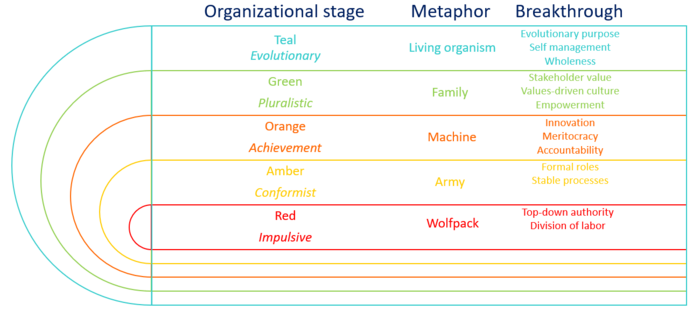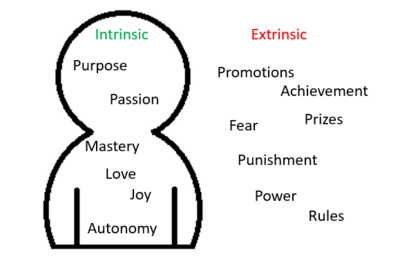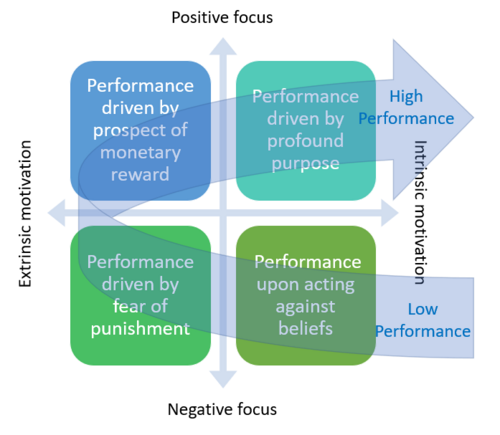Evolutionary purpose as motivational driver in project and programme management
By Søren Bojesen
Contents |
Abstract
In project or programme management, defining purpose is one of the key activities for success. On purpose, The project guide How to DO Projects: A Nordic Flavour to Managing Projects states: "Purpose gives a project direction, sets the boudaries of the project, and defines its success... Managing a project from the purpose perspective is about the adventurous and entrepreneurial spirit to dare to dream and turn dreams into reality...". This conception of purpose, is further developed by Frederic Laloux in the book Reinventing organizations. Here, in an organizational context, Laloux describes the power of a profound purpose, which is is valued over profit or competitive advantage. This profound purpose is described as an evolutionary purpose.
This article investigates how an evolutionary purpose can be used as a motivational driver in project and programme management - suggesting that a powerful purpose might be an even more important factor in achieving success with a project or programme, than on-point budgetting and scheduling. The article dives into exstrinsic versus instrinsic types of motivation and how these affect the behaviour of individuals and performance of teams. The article also gives pratical examples of how to listen to evolutionary purpose in project and programme management.
Background
Teal
A new managerial trend is occuring across industries, countries and cultures. A managerial paradigme which is changing the way we view and do organizations. The paradigme has first been described by belgian management consultant and author Frederic Laloux, as the perception of organizations as living entities where every employee extradites his/her full potential. This is a clear contrast to a more traditional view on organizations, as machines that needs to be steered and controlled and where employees are often constrained by organizational dogma and cultural hierachy.
This new manegerial paradigme has been named teal as the colour, and the name is used to distinguish the paradigme from previous paradigmes of how we have been organising ourselves in groups through history as human beings. The historic evolution of orgnisations is illustrated in Figure 1. Forming the foundation of teal are three pillars; Self management, wholeness and evolutionary purpose. The concept of evolutionary purpose is the perception, that an organization has a profound sense of purpose and that great things can happen if an organization finds a way to listen to and make decisions based on this evolutionary purpose.
Teal in project management
Laloux doesn't spend much time discussing teal from a project or programme management point of view. This is a consequence of the anti-managerial nature of teal, in which decisions are being made on the floor and no one has the authority over anyone else. Planning and budgetting are not recommended, as he believes these concepts limit agility and flexibility of projects and project deliverables. This, of course is very far from conventional project management practices, as we know from the many standards there are on the topic.
To be able to follow the guidelines of Laloux, requires a highly developed sense of consciousness within an organization and certainly within the governance boards and management teams of projects and programmes - and should the pratices of Laloux be followed without such high level of consciousness, the project is at a high risk of shut down (by the governance board, due to mismanagement) or in other ways become a failure as a result of contradicting practices. Ironically, the concept of purpose in project management and the ability to create a purpose in a project is broadly considered a key parameter in succeeding with projects. This is emphasized in the project guide How to DO Projects: A Nordic Flavour to Managing Projects, where purpose is described as one of the four main themes of project management, covering broadly from the defining the scope of the project to answering the great underlaying question: Why is this project important?
Therefore, it seems apparent that it should be possible to listen to an evolutionary purpose in project and programme mangement, while still managing the project using conventional project management approaches. But how exactly does the evolutionary purpose of Laloux differentiate itself from the typical concept of purpose in project management?
The purpose in project management is a sort of manegerial concept to motivate the project team and stakeholders, by stating why a project is important. In other words, the project manager or project management team imposes a purpose to a project as an overall context to the project deliverable(s). An evolutionary purpose is different, as it has to come from the project team members or stakeholders themselves, it cannot be imposed. Also, having an evolutionary purpose in a project team would mean having a purpose which would be treasured higher than the project deliverables themselves - which takes the project to a sort-of programme meta-level, where a project failing to produce its deliverables can still be regarded as a success, if the project manages to produce certain benefits in accordance to the evolutionary purpose.
Performance through Purpose
So what does it mean to listen to evolutionary purpose and what exactly can it bring to a project or programmme team?
Intrinsic versus extrinsic motivation
Listening to an evolutionary purpose is to do something that makes a difference - because it makes a difference, work in an environment which fullfills - because if fullfills, to act in accordance to ones world view - because those are your world views. Basically, the things that trigger intrinsic rewards, by motivation through activities or a sense of purpose. Such types of motivation can be quite powerful, especially in a team environment as they build the coherence between people.
In relation, there are certain things in project or programme management practices which prevents us from listening to an evolutionary purpose. Examples of this are focusing on the achievement in itself, being driven by the prospect of a reward, acting due to fear of a consequences etc. Such types of motivation are driven by extrinsic rewards. These can be damaging to teams as they will provoke egocentric thinking within individuals and obstruct coherence.
In project environments, there are typically a high focus on schedules, budgets, delivery specifications etc. All of these exercises are being done to ensure that the project stays within the triple constraints: Cost, time and quality. Unfortunately, such focus is driving extrinic motivation in the project team. This highlights the importance of purpose in projects, to balance the motivational scale towards intrinsic-based motivation and enable a coherent project team. And due to its ultimate regard an evolutinary purpose would be even more powerful in doing so.
Motivation and Performance
Motivation is one of the key factors in projects and creating motivation for projectmembers is one of the core leadership tasks for project managers.
David Rees describes a good leader as one who over long periods of time, inspires a team to perform above its regular performance level. A motivated project team have a higher contibution, ensure higher quality solutions, have higher morals and increase the chances for success in the project significantly.
On the other hand, a demotivated project team increases the risk of conflicts, stress, budget and timeframe overruns and generally jeopardizes the success of the project.
Figure 2 illustrates the combined theory of intrinsic and extrinsic rewards with Rees' general claims about motivation. The figure shows how the angle of rewards and types of motivation in project teams have a direct effect on the performance of the team.
In a typical project, motivation occurs for the individual team member through a monetary reward, perhabs even a promotion or the achivement in itself and what it may count for on the individuals resumé. These are positive angled extrinsic rewards, which will have a positive effect on the performance of the individual - yet it may be harmful for the collaboration in the team, especially in cases of clashing interests.
Moving down in the figure to the area of negative angled extrinsic rewards, decreases the performance of teams drastically. Here, the motivation is driven by fear of punishment or the prospect of the consequences of failure. This is an area we know best from totalitarian regimes, prison camps etc. Histrorically, the behavioral consequnces of being in this area is poor performance and even rebellious tendencies from groupmembers. No organization or project organization should be acting in this area in modern times.
Moving right in the figure, is the area of negative angled intrinsic rewards. This is the area of the lowest performance in the model. Needless to say, no organization should be acting in this area.
Moving back up in the upper right corner of the figure, is the positive angled intrisic rewards. Here is purpose driven motivation and the highest performance of teams. This is true because, motivation drives individuals to perform and yet doing so in a non-egocentric manner. Motivation increases the individuals contribution, both in activities but also in the energy and dedication subjected into the objective. There is a personal satisfaction related to doin tasks and a pleasureable sensation which cannot be achieved in any of the other areas of the model. In addition, this sort of behaviour is highly contagious.
Listening to evolutionary purpose
So how do you find your evolutionary purpose in your project team?
Limitations
Annotated bibliography
BOOKS, Lots of books baby!
References
- Project Team Roles and Responsibilities, Spring 2018 [1]
- Belbin Team Roles, Spring 2018 [2]
- How to successfully go through the Five Stages of Team Development, Fall 2016 [3]
- Group Dynamics and Personality Types, Fall 2014 [4]
- Designing Project Teams, Fall 2014 [5]


